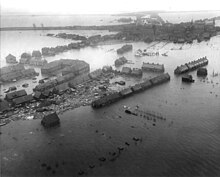
Back فيضان بحر الشمال 1953 Arabic Inundació dels Països Baixos del 1953 Catalan Povodeň v Nizozemsku 1953 Czech Stormfloden i Nordsøen 1953 Danish Flutkatastrophe von 1953 German Inundación del Mar del Norte de 1953 Spanish 1953ko Ipar Itsasoko uholdea Basque سیل دریای شمال در سال ۱۹۵۳ Persian Pohjanmeren tulva 1953 Finnish Raz-de-marée de 1953 en mer du Nord French
 Aftermath of the flood in Oude-Tonge, Goeree-Overflakkee, Netherlands | |
| Meteorological history | |
|---|---|
| Duration | 31 January – 1 February 1953 |
| Overall effects | |
| Fatalities | 2,551 |
| Damage | 9% of total Dutch farmland flooded, 187,000 animals drowned, 47,300 buildings damaged of which 10,000 destroyed |
| Areas affected | Netherlands, Belgium, United Kingdom |

The 1953 North Sea flood (Dutch: Watersnoodramp) was a major flood caused by a heavy storm surge that struck the Netherlands, north-west Belgium, England and Scotland. Most sea defences facing the surge were overwhelmed, resulting in extensive flooding.
The storm and flooding occurred at the end of Saturday, 31 January 1953 and in the morning of the next day. A combination of a high spring tide and a severe European windstorm caused a storm tide of the North Sea. The combination of wind, high tide, and low pressure caused the sea to flood land up to 5.6 metres (18 ft 4 in) above mean sea level.
Realising that such infrequent events could reoccur, the Netherlands and the UK carried out large studies on strengthening of coastal defences. The Netherlands developed the Delta Works, an extensive system of dams and storm surge barriers. The UK constructed storm surge barriers on the Thames Estuary and on the Hull where it meets the Humber Estuary.
© MMXXIII Rich X Search. We shall prevail. All rights reserved. Rich X Search